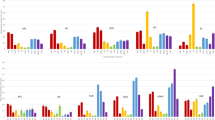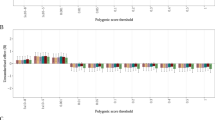Abstract
Eating disorders and schizophrenia are both moderately to highly heritable and share significant genetic risk despite distinct diagnostic criteria. Large-scale family studies on the co-aggregation of these disorders are lacking. Thus, we aimed to estimate the co-occurrence and familial co-aggregation of these disorders within the entire Swedish and Danish population. The proband cohort consisted of individuals born in Sweden (1977–2003) and Denmark (1984–2006) and still residing in their respective country at age six (NSweden = 2,535,191, NDenmark = 1,382,367). Probands were linked to their biological parents, siblings, grandparents, uncles/aunts, and cousins. Diagnoses for anorexia nervosa (AN) and other eating disorders (OED: bulimia nervosa, binge-eating disorder, and eating disorder not otherwise specified) for probands and schizophrenia diagnoses for both probands and relatives were obtained. The likelihood of having schizophrenia in those with AN or OED and their relatives was compared with individuals without eating disorder diagnoses and their relatives. Probands with AN or OED were more likely to have schizophrenia than probands without these disorders. All relatives of probands with AN or OED (except parents and uncles/aunts of probands with AN) were at increased risk of schizophrenia. In general, the magnitude of odds ratios attenuated with decreasing genetic relatedness. These results suggest familial liability contributes to the association between eating disorders and schizophrenia. Clinicians should be mindful of this comorbid and co-aggregation pattern as it may influence case conceptualization and treatment decisions.
This is a preview of subscription content, access via your institution
Access options
Subscribe to this journal
Receive 12 print issues and online access
$259.00 per year
only $21.58 per issue
Buy this article
- Purchase on Springer Link
- Instant access to full article PDF
Prices may be subject to local taxes which are calculated during checkout


Similar content being viewed by others
References
World Health Organization. Mental disorders. 2017. http://www.who.int/mediacentre/factsheets/fs396/en/.
Beidel DC, Bulik CM, Stanley MA. Abnormal psychology. 3rd ed. NJ: Pearson Education; 2014. p. 621.
Arcelus J, Mitchell AJ, Wales J, Nielsen S. Mortality rates in patients with anorexia nervosa and other eating disorders. A meta-analysis of 36 studies. Arch Gen Psychiatry. 2011;68:724–31.
Swinbourne JM, Touyz SW. The co-morbidity of eating disorders and anxiety disorders: a review. Eur Eat Disord Rev. 2007;15:253–74.
Bulik CM, Reichborn-Kjennerud T. Medical morbidity in binge eating disorder. Int J Eat Disord. 2003;34:S39–46.
Hilker R, Helenius D, Fagerlund B, Skytthe A, Christensen K, Werge TM, et al. Heritability of schizophrenia and schizophrenia spectrum based on the Nationwide Danish Twin Register. Biol Psychiatry 2018;83:492–8.
Klump KL, Suisman JL, Burt SA, McGue M, Iacono WG. Genetic and environmental influences on disordered eating: an adoption study. J Abnorm Psychol. 2009;118:797–805.
Lichtenstein P, Yip BH, Bjork C, Pawitan Y, Cannon TD, Sullivan PF, et al. Common genetic determinants of schizophrenia and bipolar disorder in Swedish families: a population-based study. Lancet. 2009;373:234–9.
Sullivan PF, Kendler KS, Neale MC. Schizophrenia as a complex trait: evidence from a meta-analysis of twin studies. Arch Gen Psychiatry. 2003;60:1187–92.
Bulik-Sullivan B, Finucane HK, Anttila V, Gusev A, Day FR, Loh PR, et al. An atlas of genetic correlations across human diseases and traits. Nat Genet. 2015;47:1236–41.
Duncan L, Yilmaz Z, Gaspar H, Walters R, Goldstein J, Anttila V, et al. significant locus and metabolic genetic correlations revealed in genome-wide association study of anorexia nervosa. Am J Psychiatry. 2017;174:850–8.
Bou Khalil R, Hachem D, Richa S. Eating disorders and schizophrenia in male patients: a review. Eat Weight Disord. 2011;16:e150–6.
Striegel-Moore RH, Garvin V, Dohm FA, Rosenheck RA. Psychiatric comorbidity of eating disorders in men: a national study of hospitalized veterans. Int J Eat Disord. 1999;25:399–404.
Lyketsos GC, Paterakis P, Beis A, Lyketsos CG. Eating disorders in schizophrenia. Br J Psychiatry 1985;146:255–61.
Rasmussen AR, Reich D, Lavoie S, Li E, Hartmann JA, McHugh M, et al. The relation of basic self-disturbance to self-harm, eating disorder symptomatology and other clinical features: exploration in an early psychosis sample. Early Interv Psychiatry. 2019:1–8. https://doi.org/10.1111/eip.12850.
Cannon M, Walsh E, Hollis C, Kargin M, Taylor E, Murray RM, et al. Predictors of later schizophrenia and affective psychosis among attendees at a child psychiatry department. Br J Psychiatry. 2001;178:420–6.
Solmi F, Melamed D, Lewis G, Kirkbride JB. Longitudinal associations between psychotic experiences and disordered eating behaviours in adolescence: a UK population-based study. Lancet Child Adolesc Health. 2018;2:591–9.
DeVylder JE, Lukens EP. Family history of schizophrenia as a risk factor for axis I psychiatric conditions. J Psychiatr Res. 2013;47:181–7.
Ludvigsson JF, Almqvist C, Bonamy AK, Ljung R, Michaelsson K, Neovius M, et al. Registers of the Swedish total population and their use in medical research. Eur J Epidemiol. 2016;31:125–36.
Axelsson O. The Swedish medical birth register. Acta Obstet Gynecol Scand. 2003;82:491–2.
Ludvigsson JF, Andersson E, Ekbom A, Feychting M, Kim JL, Reuterwall C, et al. External review and validation of the Swedish national inpatient register. BMC Public Health. 2011;11:450.
American Psychiatric Association. Diagnostic and statistical manual of mental disorders: DSM-IV-TR. Washington, DC: American Psychiatric Association; 2000.
Birgegard A, Bjorck C, Clinton D. Quality assurance of specialised treatment of eating disorders using large-scale Internet-based collection systems: methods, results and lessons learned from designing the Stepwise database. Eur Eat Disord Rev. 2010;18:251–9.
Pedersen CB, Gotzsche H, Moller JO, Mortensen PB. The Danish Civil Registration System. A cohort of eight million persons. Dan Med Bull. 2006;53:441–9.
Knudsen LB, Olsen J. The Danish Medical Birth Registry. Dan Med Bull. 1998;45:320–3.
Statistics Denmark. Documentation variables (Times). 2019. https://www.dst.dk/da/Statistik/dokumentation/Times/.
Mors O, Perto GP, Mortensen PB. The Danish Psychiatric Central Research Register. Scand J Public Health. 2011;39:54–7.
Lynge E, Sandegaard JL, Rebolj M. The Danish National Patient Register. Scand J Public Health. 2011;39:30–3.
Schizophrenia Working Group of the Psychiatric Genomics Consortium, Ripke S, Neale BM, Corvin A, JTR Walters, Farh K-H, et al. Biological insights from 108 schizophrenia-associated genetic loci. Nature. 2014;511:421.
Yao S, Kuja-Halkola R, Thornton LM, Runfola CD, D’Onofrio BM, Almqvist C, et al. Familial liability for eating disorders and suicide attempts: evidence from a Population Registry in Sweden. JAMA Psychiatry. 2016;73:284–91.
Schaumberg K, Jangmo A, Thornton LM, Birgegård A, Almqvist C, Norring C, et al. Patterns of diagnostic transition in eating disorders: a longitudinal population study in Sweden. Psychol Med. 2018;49:819–27.
Power RA, Kyaga S, Uher R, MacCabe JH, Långström N, Landen M, et al. Fecundity of patients with schizophrenia, autism, bipolar disorder, depression, anorexia nervosa, or substance abuse vs their unaffected siblings. JAMA Psychiatry. 2013;70:22–30.
Bulik CM, Thornton LM, Root TL, Pisetsky EM, Lichtenstein P, Pedersen NL. Understanding the relation between anorexia nervosa and bulimia nervosa in a Swedish national twin sample. Biol Psychiatry. 2010;67:71–7.
Javaras KN, Rickert ME, Thornton LM, Peat CM, Baker JH, Birgegård A, et al. Paternal age at childbirth and eating disorders in offspring. Psychol Med. 2017;47:576–84.
Sipos A, Rasmussen F, Harrison G, Tynelius P, Lewis G, Leon DA, et al. Paternal age and schizophrenia: a population based cohort study. BMJ. 2004;329:1070.
Watson HJ, Yilmaz Z, Thornton LM, Hübel C, Coleman JRI, Gaspar HA, et al. Genome-wide association study identifies eight risk loci and implicates metabo-psychiatric origins for anorexia nervosa. Nat Genet. 2019;51:1207–14.
Lee PH, Anttila V, Won H, Feng Y-CA, Rosenthal J, Zhu Z, et al. Genomic relationships, novel loci, and pleiotropic mechanisms across eight psychiatric disorders. Cell. 2019;179:1469–82.e11.
Kotov R, Krueger RF, Watson D, Achenbach TM, Althoff RR, Bagby RM, et al. The hierarchical taxonomy of psychopathology (HiTOP): a dimensional alternative to traditional nosologies. J Abnorm Psychol. 2017;126:454–77.
Bulik C, Devlin B, Bacanu S-A, Thornton L, Klump K, Fichter M, et al. Significant linkage on chromosome 10p in Families with bulimia nervosa. Am J Hum Genet. 2003;72:200–7.
Faraone SV, Meyer J, Matise T, Svrakic D, Pepple J, Malaspina D, et al. Suggestive linkage of chromosome 10p to schizophrenia is not due to transmission ratio distortion. Am J Med Genet. 1999;88:607–8.
Solmi F, Mascarell MC, Zammit S, Kirkbride JB, Lewis G. Polygenic risk for schizophrenia, disordered eating behaviours and body mass index in adolescents. Br J Psychiatry. 2019;215:428–33.
Dalman C, Broms J, Cullberg J, Allebeck P. Young cases of schizophrenia identified in a national inpatient register. Soc Psychiatry Psychiatr Epidemiol. 2002;37:527–31.
Ekholm B, Ekholm A, Adolfsson R, Vares M, Osby U, Sedvall GC, et al. Evaluation of diagnostic procedures in Swedish patients with schizophrenia and related psychoses. Nord J Psychiatry. 2005;59:457–64.
Jakobsen KD, Frederiksen JN, Hansen T, Jansson LB, Parnas J, Werge T. Reliability of clinical ICD-10 schizophrenia diagnoses. Nord J Psychiatry. 2005;59:209–12.
Liang H, Olsen J, Yuan W, Cnattingus S, Vestergaard M, Obel C, et al. Early life bereavement and schizophrenia: a nationwide cohort study in Denmark and Sweden. Medicine. 2016;95:e2434.
Attia E, Steinglass JE, Walsh BT, Wang Y, Wu P, Schreyer C, et al. Olanzapine versus placebo in adult outpatients with anorexia nervosa: a randomized clinical trial. Am J Psychiatry. 2019;176:449–56.
Acknowledgements
RZ was supported by Chinese Scholarship Council (CSC201700260258) and by the Swedish Medical Association #777621 (PI: SB). LVP was supported by the Lundbeck Foundation (grant no R276-2017-4581). CMB acknowledges funding from the Swedish Research Council (VR Dnr: 538-2013-8864).
Author information
Authors and Affiliations
Corresponding author
Ethics declarations
Conflict of interest
CMB has served on scientific advisory boards for Shire, serves as a consultant for Idorsia, and received royalties from Pearson (all outside the submitted work). HL has served as a speaker for Evolan Pharma and Shire and has received research grants from Shire (all outside the submitted work).
Additional information
Publisher’s note Springer Nature remains neutral with regard to jurisdictional claims in published maps and institutional affiliations.
Supplementary information
Rights and permissions
About this article
Cite this article
Zhang, R., Larsen, J.T., Kuja-Halkola, R. et al. Familial co-aggregation of schizophrenia and eating disorders in Sweden and Denmark. Mol Psychiatry 26, 5389–5397 (2021). https://doi.org/10.1038/s41380-020-0749-x
Received:
Revised:
Accepted:
Published:
Issue Date:
DOI: https://doi.org/10.1038/s41380-020-0749-x
This article is cited by
-
The impact of genetic risk for schizophrenia on eating disorder clinical presentations
Translational Psychiatry (2023)
-
Genome-wide analysis of anorexia nervosa and major psychiatric disorders and related traits reveals genetic overlap and identifies novel risk loci for anorexia nervosa
Translational Psychiatry (2023)
-
The Nepean Belief Scale (NBS) as a tool to investigate the intensity of beliefs in anorexia nervosa: psychometric properties of the Italian version
Eating and Weight Disorders - Studies on Anorexia, Bulimia and Obesity (2023)
-
Co-occurring psychotic and eating disorders in England: findings from the 2014 Adult Psychiatric Morbidity Survey
Journal of Eating Disorders (2022)
-
Polygenic association with severity and long-term outcome in eating disorder cases
Translational Psychiatry (2022)



